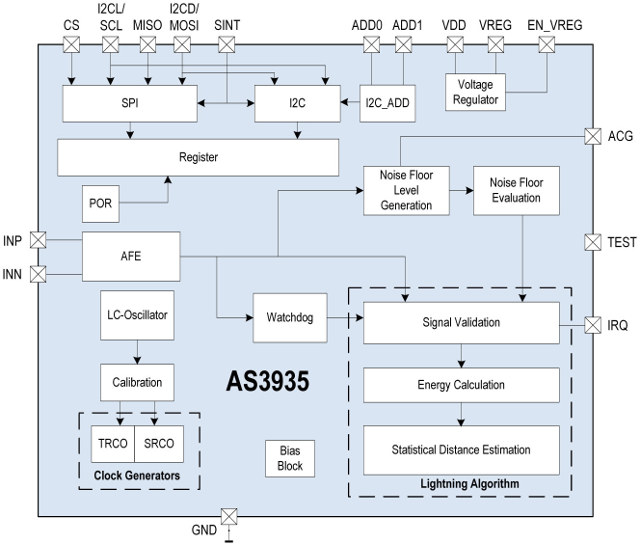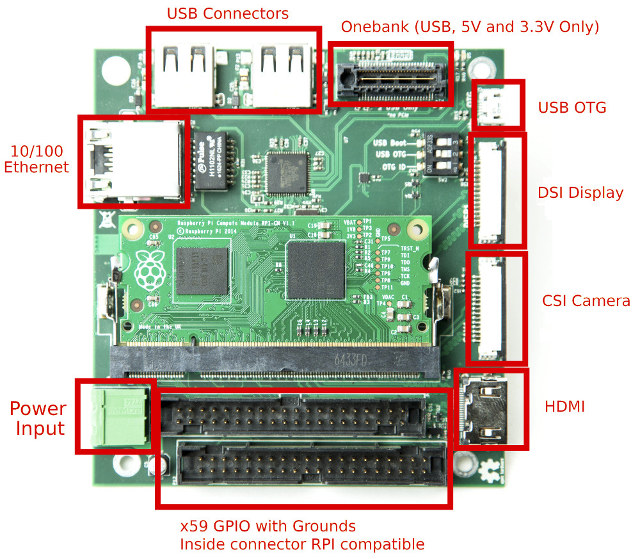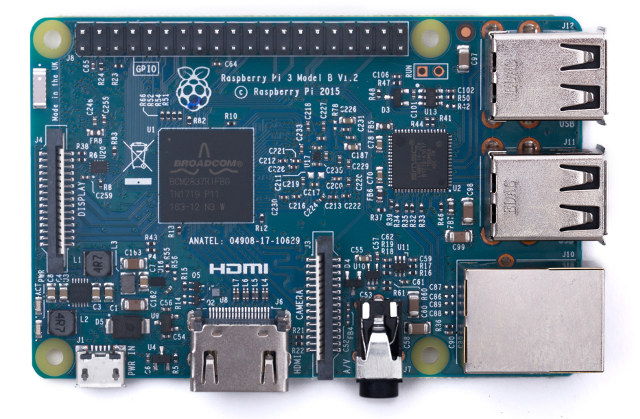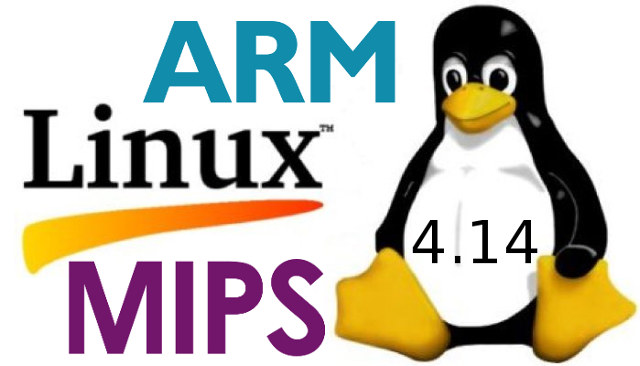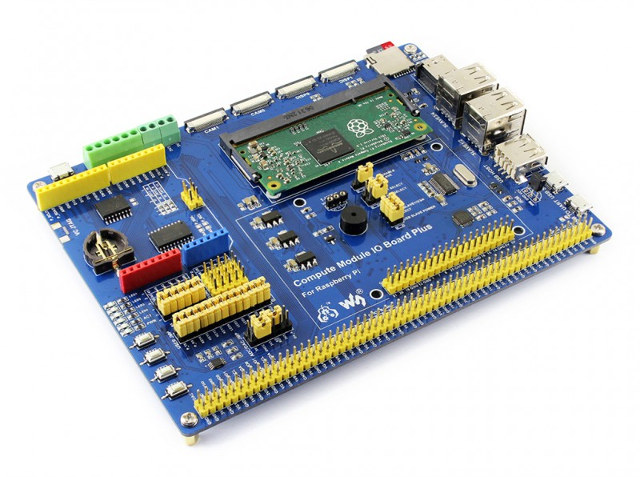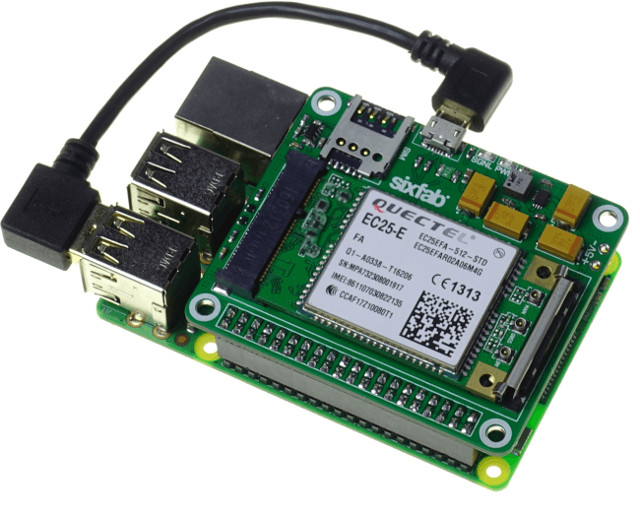Launched in 2012, AMS AS3935 Franklin lightning sensor is – at its name implies – a lightning sensing IC. The chip was designed for low power, portable or fixed wire-line applications, and beside detecting electrical emissions from lightning activity, it can also provide an estimation of the distance to the head of the storm from 40km away down to 1km, while filtering out other signals from motors, microwave ovens, etc… The chip interfaces via SPI or I2C to the host processor / micro-controller, and comes in a small MLPW-16 (4x4mm) package. Price is $3.55 per unit for 1k orders. Applications include wearables, golf carts, pool safety, portable GPS, bike computers, weather stations, uninterruptible power supplies, smart grid systems, environmental monitoring systems, etc… Basically, AS3935 can be used either for weather monitoring, or safety applications. I’ve found two maker boards with the chip: MikroElectronika Thunder Click board compatible with MikroBUS socket […]
Pi/104 Carrier Board for Raspberry Pi Compute Modules (Partially) Complies with PC/104 OneBank Specs (Crowdfunding)
The PC/104 consortium maintains various standards for embedded computer defining both the buses to use and form factors. PC/104 SBCs/boards are mainly used in rugged industrial computers, and stackable through ISA and PCIe buses. The standards were mostly designed for x86 processors, but in Q1 2015, the consortium added the OneBank option to PCI/104-Express & PCIe/104 Specification, Revision 3.0 in order to enable lower cost solutions and processors with PCIe and USB interfaces. This brought some lower powered Intel and ARM+FPGA based PC/104 compliant boards to the market such as Winsystems PX1-C415 based on Intel Apollo Lake E3900 SoC, or Sundance EMC²-Z7030 powered by Xilinx Zynq-7030 ARM+FPGA SoC. Adam Parker (Parker Microsystems) has decided to bring the PC/104 OneBank industrial standard to the Raspberry Pi world, by creating Pi/104 a carrier board for the RPi compute modules that (mostly) complies with PC/104 OneBank for factor, and exposes the required USB […]
Meet the Blue Version of Raspberry Pi 3 Board, For Brazil Only
It’s always fun to buy electronics and gadgets from China, while there are sometimes technical “headaches”, they are mostly solvable and part of the fun. But in some cases, government regulations and customs ruin the party even before you get the device. Most of the time, it’s just in the form of unexpected custom duties, but other times, you may get a phone call asking you to get some documents… With experience, I’ve learned to give up at that point, but I tried one before… The courier will usually not tell you exactly what you need, just some clues, so I’ll have to make a few phone calls… After 8 phone calls to different government officers, I discovered that I needed a document saying I do not need document… Hooray! But sadly, it could not be done over the phone, online, or by snail mail, I would have to go […]
Linux 4.14 Release – Main Changes, ARM & MIPS Architecture
Linus Torvalds has announced the release of Linux 4.14: No surprises this week, although it is probably worth pointing out how the 0day robot has been getting even better (it was very useful before, but Fengguang has been working on making it even better, and reporting the problems it has found). Sure, some of the new reports turned out to be just 0day doing things that just don’t work (ie KASAN with old gcc versions, but also doing things like loading old ISA drivers in situations that just don’t make sense – remember when you couldn’t even ask if the hardware existed or not, and just had to know), but even then it’s been all good. The appended shortlog is obviously only for the (small) haul since rc8, and it really is tiny. Not very many commits, and they are small. The biggest thing that stands out in the diffstat […]
Lab in a Box Concept Embeds x86 Server and 6 ARM Boards into a PC Case for Automated Software Testing
The Linux kernel now has about 20 millions line of code, Arm has hundreds of licensees making thousands of processors and micro-controllers, which end up in maybe hundreds of thousands of different designs, many of which are not using Linux, but for those that do, Linux must be tested to make sure it works. The same stands true for any large software used on multiple hardware platforms. Manual testing is one way to do it, but it’s time consuming and expensive, so there are software and hardware continuous integration solutions to automate testing such as Linaro LAVA (Linaro Automated Validation Architecture), KernelCI automated Linux kernel testing, and Automotive Grade Linux CIAT that automatically test incoming patch series. Both CIAT and KernelCI focus on Linux, and rely on LAVA, with KernelCI leveraging hardware contributed by the community, and proven to be effective as since it’s been implemented, failed build configs dropped […]
$50 Waveshare Compute Module IO Board Plus is Designed for Raspberry Pi CM3/CM3L Compute Modules
Raspberry Pi Compute Module CM3L and CM3 are fairy inexpensive at $25 and $30 respectively, but if you want to get the complete development kit with Compute Module IO Board, CM3 and CM3L modules, and accessories you’ll need to spend around $150 plus shipping. A cheaper option might be Waveshare “Compute Module IO Board Plus for Raspberry Pi CM3, CM3L” with many of the same features as the original Compute Module IO board, plus some extras like terminal blocks for ADC/DAC or RTC battery, which I first found on DX for $49.95 including shipping. Waveshare Compute Module IO Board Plus specifications: Compute Module socket for Raspberry Pi CM3/CM3L I/O headers 40-pin Raspberry Pi GPIO header (3) GPIO header for all pins exposed by the modules (2) Arduino headers for shields (10) 10-bit ADC/16-bit DAC screw terminals (11) 3x 5-pin sensor interface (13) 1-WIRE interface, for connecting single-bus devices like DS18B20 […]
SixFab Launches Raspberry Pi 3G-4G/LTE Base Shield V2 for $31.20
Development boards with 4G LTE are still quite expensive, at least compared to 2G or 3G solutions, with for example Wio LTE GPS Tracker board selling for around $100. So when I saw Sixfab introducing a 3G/4G shield for Raspberry Pi 3 for just $31.20 (pre-orders), I first thought it was an incredible deal. But I soon realized I missed the “base” word in the name, as the shield just includes the SIM card slot, and mPCIe connector where you can connect Quectel’s UC20-G Mini PCle 3G module or EC25 Mini PCle 4G/LTE Module which adds respectively $59 or $89 to the price. That’s still an interesting HAT board, so let’s have a look. Raspberry Pi 3G-4G/LTE Base Shield V2 specifications: Clip-in Mini PCIe socket for: 4G/LTE Module (Quectel EC25) up to 150Mbps downlink and 50Mbps uplink data rates, GPS/GLONASS 3G Module (Quectel UC20) up to 14.4Mbps downlink and 5.76Mbps […]
Telegea Smart Hub DIN Rail IoT Gateway is Powered by Raspberry Pi CM3 Module
DEK Italia has recently introduced Telegea Smart Hub, an IoT gateway based on Raspberry Pi Computer Module 3 (CM3) with Ethernet, WiFi, RS232/485 ports, and various other I/O ports, that can leverage Raspberry Pi software ecosystem. The company explains the device is mainly targeted at DIY home automation applications as a smart home controller which runs open source smart home software like OpenHAB and Home Assistant, but it can also be used for many other IoT applications. Telegea Smart Hub R3B0 specifications: SoC – Broadcom BCM2837 quad core Cortex A53 processor with VideoCore IV GPU System Memory – 1GB LPDDR2 RAM Storage – 4GB eMMC flash, 256 byte EEPROM Connectivity – 10/100M Ethernet port, optional Wifi 802.11 b/g/n at 2.4 GHz Serial – RS485 serial port, RS232 serial debug port USB – 2x USB 2.0 host ports Expansion 6xdigital inputs via screw terminals (for dry contacts or S0 interface) 4x […]


